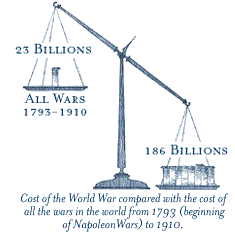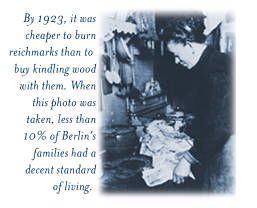Money
Matters, an IMF Exhibit -- The Importance of Global Cooperation
|
Conflict
and Cooperation (1871-1944)
|
Part
3 of 6
|
|
|
|
| |
Cost
of the World War
|
| <--Previous |
Next--> |
| |
|
As
this contemporary illustration graphically shows, the cost of the
"World War" was staggering when compared with the costs
of earlier hostilities. Governments were forced to stop redeeming
their currencies for gold, since they had to print so much paper
money to pay for the war.
|

credits
|
|
Postwar
Conundrum
|
- The
defeated countries had no gold to pay their reparations. Their
economies were exhausted, and the peace terms offered little hope
of earning gold through exports.
- Without
the reparations money, the allies could not repay their war loans
from the United States.
- The
United States refused to cancel the allies' debts, insisting that
the loans represented commercial transactions.
|
|

credits
|
What
will "the next war" cost?
|
Impossible
Debt
|
Finally,
the German, Austrian, Hungarian, Polish, and Bulgarian monetary systems
collapsed under runaway inflation called hyperinflation. The United
States loaned money to Germany through the Dawes Plan. This loan,
along with private investment, enabled the defeated countries to make
scaled-down reparations payments. However, the victors collected only
a small fraction of the reparations, and the United States eventually
had to cancel the remaining debts of its allies.
|
| |
|
|
| <--Previous |
Next--> |